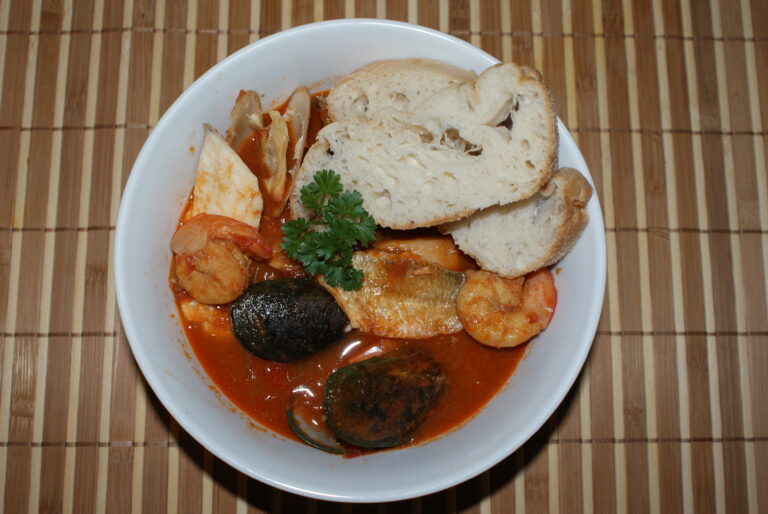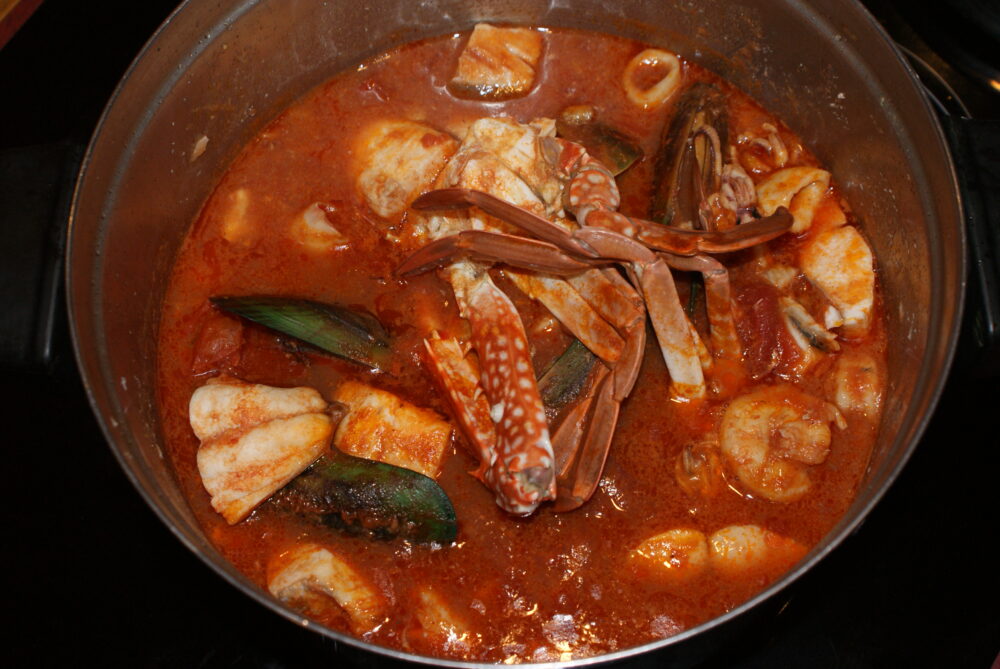Basic Bouillabaisse – By Anthony Davies
Bouillabaisse is one of the classic dishes of Provencal cuisine from the south of France. Its preparation has become more and more complicated over time, distancing it from its origins as a fisherman’s simple one pot stew prepared from the unsaleable “rubbish” portion of their catch. One such trash fish was the Racasse or rockfish, a spiky, bony member of the Scorpion fish tribe like our bullrout or fortescue. In France Raccasse is now a required item in a traditional bouillabaisse, and they are no longer a cheap fish! The name of the dish comes from the Occitan dialect words for “boil” and “reduce heat”, literally “boil, abate” in English, and refers to the cooking method of toughest fish first followed by more delicate morsels that need less time and lower temperatures.
Nowadays a typical Marseilles bouillabaisse consists of a first course of spicy soup with bread and special mayonnaise, followed by the traditional assortment of fish boiled and served separately. I suspect that development is for discerning diners to check the species and quality of the fish served.
My recipe is never going to win me a Michelin star, but I feel that it’s closer to the original concept, a way to make use of a poor catch, or to share a single small crab with the whole family. Quantities as given make a big meal for two adults or substantial starters for four.
Ingredients:
Whatever fish you’ve managed to catch on a bad day, in this case a baby permit and a nice whiting. A mix of fish types is preferred.
Leftover fresh bait – I had some nice cast netted prawns and a couple of local squid in the freezer.
A big handful of shellfish from the freezer – I had mussels and clams.
One blue swimmer crab, cleaned and quartered –optional.
A couple of large garlic cloves.
One 400g tin of crushed tomatoes.
Olive oil for cooking and salt and pepper to taste.
Dry white wine, water or fish stock.
Method:
Fillet the fish and cut into boneless bite size pieces. Traditional Bouillabaisse uses bones-in cut or whole fish, but that’s not much fun to eat for most families. Scale delicate fish like whiting or flounder, leaving the skin on, firmer fish like my permit should be skinned. At this point a real chef would make stock from the heads and frames, you are welcome to do so, but I was too lazy on this occasion.
Peel the prawns, leaving the tail on for a fancier appearance. Skin and clean the squid and cut into bite size chunks.
Peel and crush the garlic cloves. Gently fry in a large saucepan till just golden.
Add the shellfish and stir over medium heat until the shells are open. I know the rules have changed but I still discard the ones that don’t open, better safe than sorry. Add the squid pieces and stir for 5 minutes.
Before the liquid from the shellfish boils off, pour over the can of crushed tomato, cover and bring back to the boil. Add the firmer fish pieces and simmer at a medium boil for about 5 minutes. If you’ve caught that sand crab, now is the time to add the pieces to the mix.
Add the delicate fish, the prawns and a slosh of dry white wine, fish stock or water, just enough to keep the sauce “soupy” rather than “stewy”. Simmer gently for another 5 to 10 minutes, until the alcohol from the wine has boiled off and everything is cooked through.
Add salt and pepper to taste, serve in soup bowls with a side of crusty bread, slices of baguette to be authentic.
Bon appetit!








